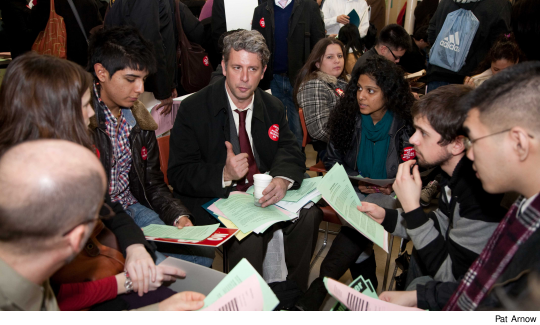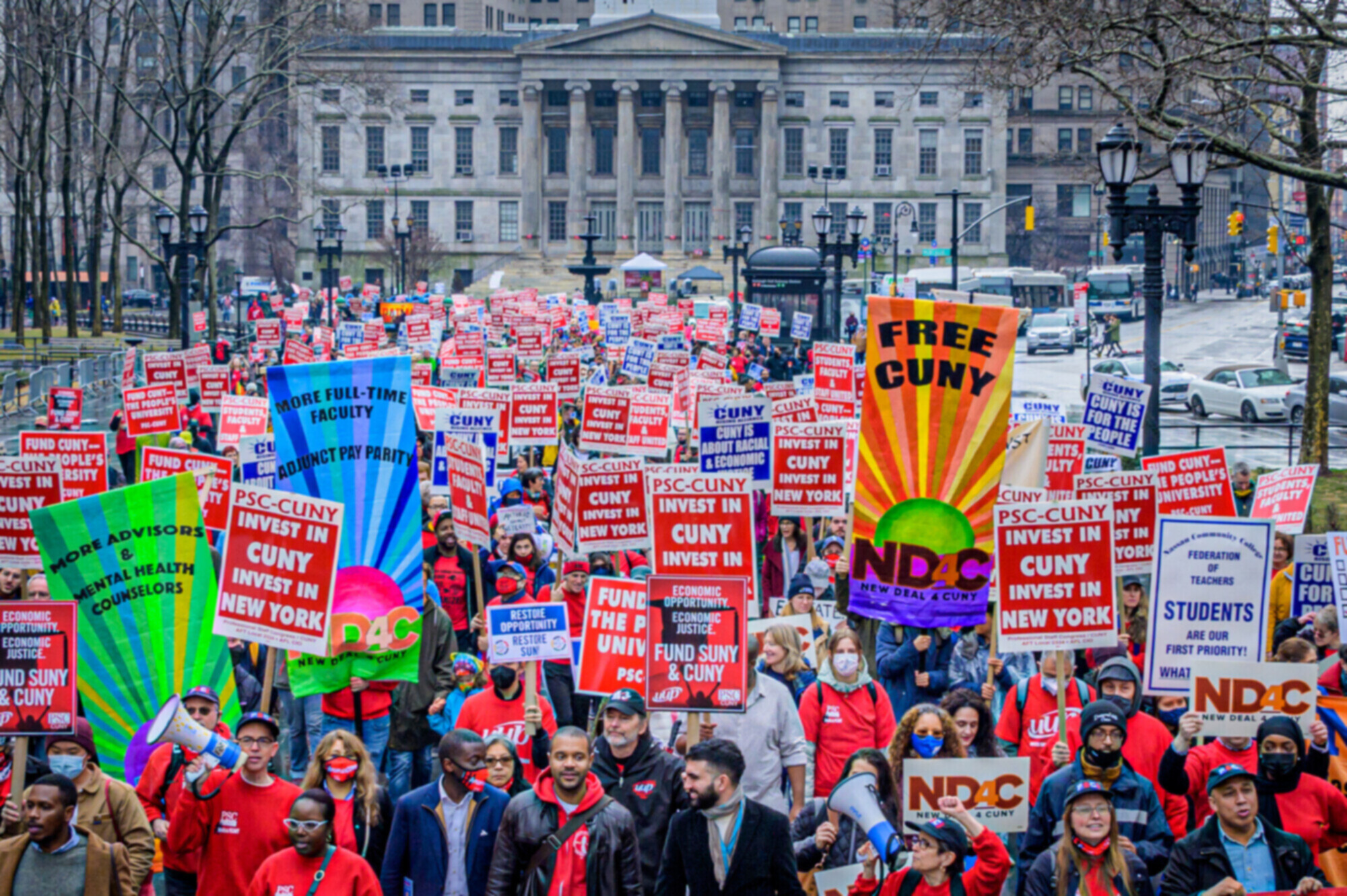 |
On March 15, hundreds of academics and college students converged on the State Capitol to press for a restoration of public funding for higher education. As Clarion went to press the state budget had not yet been adopted, and PSC activists prepared to engage in a direct action protest in Albany on March 23.
“We call on our members and other New Yorkers to join us in a peaceful, non-violent action, during which some of us are prepared to risk arrest to prevent the passage of a budget that starves the ordinary people of New York in order to protect the wealthy,” said a PSC Executive Council resolution on the March 23 demonstration.
‘A DEFINING MOMENT’
“This is a defining moment in national and New York economic policy,” Barbara Bowen, the union’s president, wrote in a message to members. “The governor’s budget slashes funds for schools, colleges, CUNY, health care and many other public services, yet includes a tax break for the highest earners.” While the Assembly’s budget proposal would restore some CUNY funding, Bowen noted, it would leave in place a 10% cut to CUNY senior colleges, and would only partially continue the modest income tax surcharge on the highest-paid people in New York.
“Without a fundamental shift in direction, the budget passed in Albany will force economic austerity on working people in order to concentrate even more wealth among the rich,” Bowen said. “We are taking a stand for an alternative,” she told Clarion.
As Clarion went to press, several community groups were pledging their support. (A report on the direct-action protest is here.)
The direct-action protest was one part of a broad effort by the PSC to bring grassroots pressure to bear on this year’s State budget decisions. The union’s campaign has included thousands of member e-mails and phone calls, a TV ad campaign, lobbying trips to the capital, testimony at legislative hearings, meetings in legislators’ local offices and more.
The rally and lobby day at the Capitol on March 15, dubbed Student-Faculty Higher Education Action Day, drew nearly 500 hundred people. It was a coalition effort by the PSC, the student government associations of both CUNY and SUNY, United University Professions (SUNY’s union of faculty and professional staff), New York Public Interest Research Group (NYPIRG), and New York State United Teachers (NYSUT).
PAYING BACK
“I was first in my family to go to college, and I saw what CUNY could do with underprivileged families,” said Sharif Elhakem, a Lehman alumnus who now works at Lehman as a senior CLT. “And that is why I’m here – I want to give a little back.”
“I received help in the form of financial aid. It enabled me to get a career,” explained Elhakem, who also teaches chemistry as an adjunct faculty member. “I am here to fight for all the students who are in the situation that I was in 15 years ago.”
Gov. Cuomo’s proposed budget, if enacted, would cut funding for CUNY senior colleges by $95.1 million and for CUNY community colleges by $17.5 million. SUNY would be cut by another $100 million, and support for community college statewide would be reduced by the equivalent of $226 per full-time student over the academic year. CUNY and SUNY have faced three years of deep cuts in state support, leading to larger classes and reduced course offerings, at a time when enrollments are rising to record levels. Many students have had their aid cut by Gov. Cuomo’s rule changes for the Tuition Assistance Program (TAP).
“It’s time for students to get involved with the decisions getting made,” said Domingo Estevez, a BMCC student who got on the bus to Albany on March 15. “I put ‘Actions, Not Words,’ on my Facebook page – in Latin, ‘Acta Non Verba.’”
In mid-March, more than 3,100 PSC members sent messages to Cuomo and their State representatives, urging restoration of funding for CUNY and renewal of the current surcharge on top incomes.
TV & RADIO BLITZ
TV and radio ads took the same pro-CUNY message to broadcast and cable channels in New York City and Albany in the last two weeks of March. In New York City, the PSC’s ad ran on WABC, WNBC, WCBS, CNN, NY1, MSNBC and other stations. (See the video here.) It was a popular perspective: in a February Siena poll, 56% of respondents were opposed to reducing CUNY and SUNY funding.
Detailed budget testimony was another part of the PSC’s push for fair funding. President Bowen spoke at a joint hearing of the State Senate’s Finance Committee and the Assembly’s Ways and Means Committee on February 10, and members who work at community colleges testified at a City Council hearing on March 18.
PSC activists also traveled to Albany to meet with legislators on March 7-8 and 21-22. “We pointed out that to strengthen the economy, it’s necessary to invest in higher education,” said Joel Berger, a member of the Retirees Chapter. “During the Depression, Brooklyn and Queens Colleges were created. So even in those hard times, they made the right decisions.”
Coalitions like New Yorkers for Fiscal Fairness and Strong Economy for All have brought unions and community groups together against Cuomo’s cuts. On March 9, SEIU 1199 President George Gresham told reporters that letting the income tax surcharge expire would be a choice to let the wealthy “prosper on the backs of our children, on the backs of working people.” The alternative, he said, is “to make sure the wealthy pay their fair share.”
DIRECT ACTION
As the April 1 deadline for a new State budget drew closer, it was unclear which choice New York’s Legislature would make. “That’s why I signed up for the direct-action protest ,” said Lorraine Cohen, professor of sociology at LaGuardia and chair of its PSC chapter. “The stakes are so high for all of us. We need to focus attention on the issues and push Cuomo and the legislature to do the right thing. Democracy means they are supposed to represent the interests of the majority, not the top 1%. That’s what we want – democracy.”
For more budget-related coverage in Clarion, click here and here.

